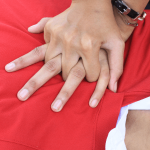Asthma Attack First Aid In Children

It is often said that asthma is not diagnosed in children under the age of two years old, but actually children can often suffer from a viral-induced wheeze up to 5 years old, and still not warrant an asthma diagnosis.
This is because children have so many viral illnesses when they are in infancy and toddlerhood.
If your child has any sort of wheeze, you should always seek medical help. It could be a simple viral wheeze, but also children can have noisy breathing when they have swallowed a foreign object and have a partial obstruction.
Although your child may be given a blue inhaler, this does not mean that they have an asthma diagnosis. Small children are often given blue inhalers for wheeze episodes and viral illnesses.
Asthma Attack First Aid
It is not unusual for baby’s first aid kit in the home, to contain an inhaler and spacer.
If your child is eventually given an asthma diagnosis, they will receive the appropriate medication, likely inhalers, and an asthma action plan.
The action plan should be kept on the child at all times with the medication, and a colour copy of the action plan should also be given to the daycare or school.

Your child may be given two inhalers. One called a reliever, which will likely be blue, and one called a steroid inhaler which is commonly red/brown/orange or purple.
The steroid inhaler is what we call a ‘preventative’ inhaler, and this treats the underlying causes of the symptoms, where as the blue inhaler is for instant relief when needed. If your child is needing their blue inhaler regularly, it may be time to visit your GP and see if they need a preventative inhaler.
As a paediatric nurse I can confirm that it is not always an easy taks administering an inhaler to a toddler or a baby. The process of covering their mouth and nose with the spacer can feel very confronting for them, and uncomfortable. The blue inhaler also has a specific smell, which not all children enjoy!
Often children will need to be held to have their medication, and this can be distressing for them and the parents, however it is important that the medication is given and even though they are crying, they are still receiving the medication into the lungs.
The steroid dose in an inhaler is a very small amount. This is because when you give an inhaler, the medicine is going straight to the inside of the lung where it is needed. Tablets and syrup are broken down through the stomach and liver before doing their job. This is why the inhaled steroid only needs to be a small amount.
In the children’s hospital, we used to term some babies as ‘happy wheezers’, as they would usually be admitted with a wheeze and a viral illness, but they were otherwise well, eating and drinking but there would often be an audible wheeze while they bounced around in the cot and smiled all day!
Asthma Symptoms
Mild/moderate symptoms
- Some difficulty breathing
- Able to talk in full sentences (older children)
- Able to walk/run around
- Might have a cough or wheeze
Severe symptoms
- Difficulty breathing
- Cant speak full sentences (older children)
- Skin sucking in at the base of the neck &/or ribs
- May have a cough or wheeze
- Blue reliever medication not lasting as long as it should.
Life threatening symptoms
- Gasping for breath
- Unable to speak 1-2 words
- Exhausted
- Confused
- Colour change – blue tinge
- Pale & floppy/collapse
- May not have wheeze anymore (no air entry)
- Not responding to blue reliever medication at all
4x4x4 Asthma First Aid Steps:
- Sit the child on your lap
- Try to keep them calm
- Retrieve the blue reliever puffer and spacer
- Shake the puffer
- Place the child in an appropriate position where you can effectively hold them
- Make sure the spacer is positioned properly around the child’s nose and mouth
- Administer one puff of the blue inhaler into the spacer
- Ask them to take 4 breaths through the spacer, or if the child is fighting, wait until they have taken 4 breaths
- If the child is very distressed, you may need to give them a break for 1 minute after 2 puffs
- Repeat until a total of 4 puffs and 16 breaths have been administered

11. Wait 4 minutes
12. If there is no improvement, repeat from step 7.
13. If breathing continues the same or worse after the second round of treatment, call an ambulance
14. Keep giving 4 seperate puffs every 4 minutes until the ambulance arrives
15. If the casualty stops breathing at any time, start CPR and make sure an ambulance is on its way
Baby CPR Course
Our baby first aid courses are available as in-home courses, public courses or as a pre-recorded online course which you can access anytime and complete self-paced, and we also have the option of a live group online class.
We run classes in your home with groups of 2, 4 or up to 10 in Sydney & Melbourne and you can book in 3 easy steps!
- Pick your class
- Follow the prompts to purchase
- We will contact you within 24 hours to lock in your date of choice
Here are some other resources you may enjoy!
- FREE GUIDE: Introducing Common Allergy Foods & Allergic Reactions
- Book a baby & child first aid class in your home
- Online Baby & Child First
- Got questions? Head to our FAQ page

